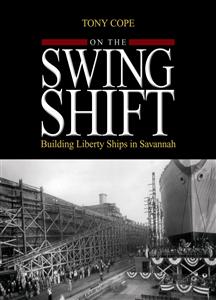
ON THE SWING SHIFT
Building Liberty Ships In Savannah
by Tony Cope
—
238pp., 55 b/w photos
ISBN 978-1-59114-123-5
Hardcover, $26.95
Naval Institute Press
—
Savannah Native Johnny Mercer wrote a number of songs during World War II that reflected the social climate of the times both at home and among the men and women in the service overseas. The song On the Swing Shift from the film Star Spangled Rhythm included the lines;
“Life is fine with my baby on the swing shift
On the line with my baby on the swing shift”
These lyrics portrayed a romantic, if not totally accurate, picture of men and women working together – not for the first time, but for the first time in huge numbers, in defense plants across America. One of those plants built Liberty Ships in Mercer’s hometown, Savannah.
During World War II, the 2,710 Liberty ships built in America forged the lifeline that kept our Allies and our own military forces in the fight that led to ultimate victory. Eighty-eight of those Libertys were launched at the Southeastern Shipbuilding Corporation in Savannah, Georgia. On The Swing Shift – Building Liberty Ships In Savannah tells the story of the men who built those ships; men who in many cases came from rural areas and who had never seen a ship, much less helped to build one. It’s about women who took construction jobs in a man’s world and performed as well as the men with whom they worked. The book is about African-Americans who in the days of a segregated South, were not allowed to rise above the roles of custodians and “helpers”.
For many of these people it was not portholes, ladders, the bow, the stern, port and starboard, it was “round windows”, “the pointy end”, “upstairs and downstairs”, “right and left”. Many were taken straight out of high school, other were in their 70’s and 80’s. They lived in places called Pine Gardens, Tattnall Homes, Deptford Place and Moses Rogers Grove. They car-pooled from Clyo, Springfield, Statesboro and Brooklet. These men and women worked in the heat and mosquitoes and they worked in the bitter cold. Their work was dangerous and sometimes boring, but many worked double shifts and often seven days a week. There were more than 45,000 of them during the four years of the shipyard’s existence and in spite of all of the problems faced, they built ships and they built them well.
Few remember the Liberty ships, even fewer in Savannah know or remember the shipyard, or that the Southeastern Shipbuilding Corporation was the largest industry ever located there. They should remember; remember the ships, the men and women who built them, and the men who sailed them. Many argue that the Battle of the Atlantic was the most critical of the war. That battle and many others might well have been lost if it had not been for the Liberty ships. Eighty-eight of them were built just off President Street in Savannah.